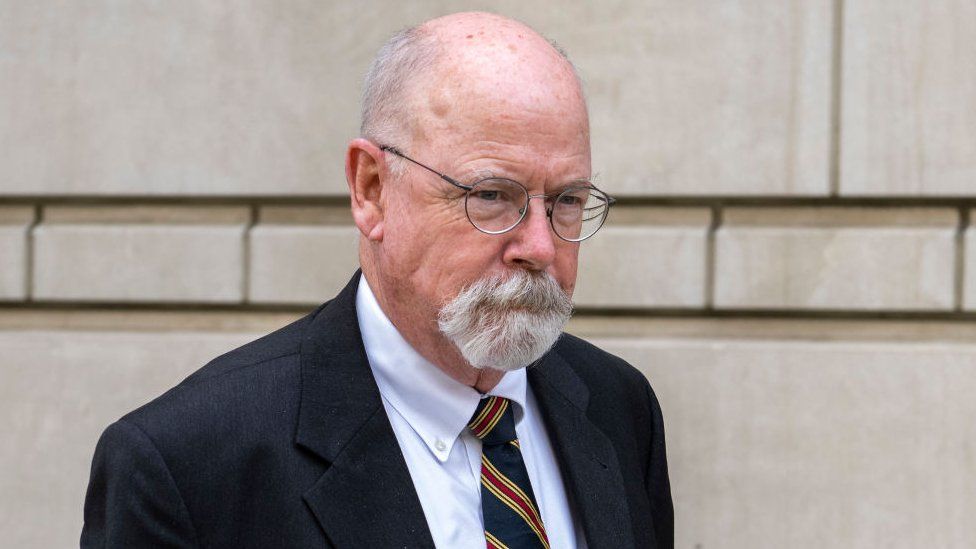
Getty Images
Durham suggests Nellie Ohr planted the seeds of sourcing for the most explosive allegations leveled by the dossier against Trump, including the oft-cited notion that he and his campaign were engaged in a “well-developed conspiracy of cooperation” with the Kremlin.
While it’s bad enough the debunked dossier the FBI used to spy on the Trump campaign was paid for by the Clinton campaign and authored by a foreign FBI informant and his carousing researcher, the newly released report of Special Counsel John Durham strongly suggests a top Justice Department official and his wife had an early hand in shaping the political rumor sheet.
According to the 306-page report, former Justice Department prosecutor Bruce Ohr’s wife Nellie Ohr first plowed the ground for the dossier with a series of research reports she wrote for Fusion GPS, the D.C.-based opposition research firm the Clinton campaign commissioned to dig up dirt on Trump and Russia.
Obtained by Durham, her reports zeroed in on Sergei Millian and his connections to Russia and Trump, falsely portraying him as a key intermediary between the Kremlin and the Republican candidate. They would later provide the foundation for the dossier’s many fictions.
“Fusion GPS records demonstrate that Nellie Ohr first identified Millian,” Durham states in his report. “All told, Ohr prepared at least 12 reports that discussed Sergei Millian.”
She wrote her first Millian report in April 2016, the month before Fusion GPS hired former British intelligence officer Christopher Steele to put his imprimatur as a supposed former “spy” and “Russian insider” on the dossier.
“This report was prepared just ten days after Fusion GPS was retained by [Clinton campaign law firm] Perkins Coie to conduct opposition research on Trump,” the Durham Report states, “and prior to Steele being retained by Fusion GPS.”
Durham suggests Nellie Ohr planted the seeds of sourcing for the most explosive allegations leveled by the dossier against Trump, including the oft-cited notion that he and his campaign were engaged in a “well-developed conspiracy of cooperation” with the Kremlin. The dossier attributed this, falsely, to Millian. Durham found that the Belarusian-American realtor was never a source for the dossier and was simply invented as one, along with the allegations attributed to him.
In fact, Durham says that Millian initially wasn’t even on the radar of Steele and his dossier “collector” Igor Danchenko, a former Brookings Institution analyst who’s admitted much of the information he provided Steele was alcohol-lubricated gossip. Millian was called to their attention by Nellie Ohr, who the prosecutor said “implicated” Millian through her own reports. Durham suggests Steele and Danchenko merely followed her leads.
Meanwhile, the prosecutor added, Bruce Ohr, an anti-Trump Democrat, pushed his wife’s reports that cited Millian — 12 in all — onto the Crossfire Hurricane team at FBI headquarters that was investigating Trump and his campaign for possible espionage. Agents used her reports as a source of corroboration for the Steele reports they received in the summer and fall of 2016, even though it was circular reporting.
“The reports prepared by Ohr and others at Fusion GPS were ultimately provided to Crossfire Hurricane investigators by Ohr’s husband, Bruce Ohr,” according to the Durham Report.
Durham notes that Danchenko was tracking leads on Millian from Nellie Ohr within “approximately one week” of Fusion GPS retaining Steele to compile the dossier. He concludes that this “strongly supports the inference that Fusion GPS directed Steele to pursue Millian.”
In other words, Steele was not the catalyst behind the dossier’s central claims. Rather, it was Clinton’s contractor Fusion GPS — but more specifically, the wife of a senior DOJ official who worked for Fusion. So the FBI wasn’t really investigating “Crown reporting,” as officials referred to Steele’s dossier, implying it was British intelligence. More accurately, it was investigating information from inside its own department that was laundered through Steele and his dossier.
On page 97 of their book, “Crime in Progress,” Fusion GPS co-founders Glenn Simpson and Peter Fritsch maintained that it was Steele who identified Millian as “one of the key intermediaries between Trump and the Russians.” Durham’s report shatters their claim.
The special counsel also found that Simpson worked with Bruce Ohr to pressure the FBI to investigate the dossier allegations.
On Aug. 22, 2016, Simpson asked Ohr to call him. About an hour later, Ohr emailed the FBI agent handling Steele as an informant to, as he said, “check in.” Ohr and the agent, Michael Gaeta, spoke over the phone on Aug. 24. During their call, Ohr inquired if the FBI was going to do anything with the dossier reports that Steele had passed along to Gaeta in July. In response, Gaeta “told Ohr that a group at FBI headquarters was working on them,” according to the Durham report. This undercuts the official FBI timeline of when HQ first received the dossier. For years, the bureau has insisted it did not receive the reports until a month later — Sept. 19, 2016.
The Ohrs also appear to have directly influenced the dossier and the FBI’s investigation. Both Bruce and Nellie Ohr, who previously worked for the CIA, met with Steele in Washington at a critical time. Emails reveal that on July 30, 2016 — the day before the FBI formally opened its overarching case against Trump, codenamed “Crossfire Hurricane” — the couple sat down with Steele and an unidentified “associate” of his at the Mayflower Hotel in D.C. to compare notes — Nellie and Steele literally passed pieces of papers back and forth — regarding their research into “suspicions that Russian government figures were supporting the candidacy of Donald Trump.” After their breakfast, Bruce Ohr reportedly contacted then-deputy FBI director Andrew McCabe to relay their concerns.
Fusion GPS also pitched the press the false narrative that Millian was a key intermediary between Trump and Russia. For example, on June 27, 2016, Fritsch sent an email to Franklin Foer, a reporter at Slate magazine, stating “this dude is key” and claiming “he is clearly kgb.”
The next month, Simpson reached out to ABC News producer Matthew Mosk about Millian. Mosk emailed Simpson and reported back that he was “making arrangements to interview Millian on camera” and that he and Simpson “should chat.” On July 29, 2016, Millian ultimately was interviewed by Brian Ross, formerly of ABC News, who asked Millian whether he was a Russian spy.
On Sept. 13, 2016, Mosk emailed Simpson and asked, “What’s the most official thing we have showing Millian tied to Trump? That would make it hard for the Trump org to disavow Millian?”
Ross later left ABC after being suspended for erroneous reporting on Russiagate, while Mosk has moved to CBS News.
Throughout the summer and fall of 2016, Fusion GPS also promoted to the Washington media the false allegation the Trump campaign maintained a secret hotline to Moscow through Russia-based Alfa Bank. In an attempt to tie Millian to the Alfa Bank allegations, Durham found that Fusion GPS sought the assistance of Clinton campaign lawyer Michael Sussmann, who in turn contacted D.C. tech executive Rodney Joffe to determine if Millian had any ties to Alfa Bank.
On Aug. 20, 2016, Joffe emailed federal computer contractors at Georgia Tech a document titled “birdsnest-1.pdf’ that contained “known associates” of Trump. Included in the attached document was a description of Millian along with his past mailing addresses; various email addresses; websites; and IP addresses that were associated with him. Joffe, who was recently fired as an FBI informant, described Millian as “the most likely intermediary” between Trump and Russia.
On Sept. 27, 2016, Simpson and Fritsch emailed IP “look-up” information for one of Millian’s websites to then-New York Times reporter Eric Lichtblau, whom Fusion was pressuring to write a story about the Trump-Alfa Bank allegations. In the email, Fritsch pointed out that “Alfa” was the website service provider for Millian’s website. However, Durham determined that the relevant IP information did not indicate that “Alfa Bank” was the service provider, but rather Alfa Telecom — a Lebanese-based telecom company, which appears to have no affiliation with Alfa Bank.
Fusion GPS and Steele also provided the substance of the Alfa Bank allegations to Bruce Ohr, the DOJ official, who passed the false tip on to the FBI. The Crossfire Hurricane team used Ohr as a conduit to continue to receive information from Steele about Trump throughout 2017, even after the FBI had to terminate Steele as an informant for leaking information about its investigation to the media.
This article was originally published by RealClearInvestigations and made available via RealClearWire.









